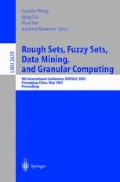Abstract
In this study, we introduce a concept of Rule-based fuzzy polynomial neural networks(RFPNN), a hybrid modeling architecture combining rule-based fuzzy neural networks(RFNN) and polynomial neural networks(PNN). We discuss their comprehensive design methodology. The development of the RFPNN dwells on the technologies of Computational Intelligence(CI), namely fuzzy sets, neural networks, and genetic algorithms. The architecture of the RFPNN results from a synergistic usage of RFNN and PNN. RFNN contribute to the formation of the premise part of the rule-based structure of the RFPNN. The consequence part of the RFPNN is designed using PNN. We discuss two kinds of RFPNN architectures and propose a comprehensive learning algorithm. In particular, it is shown that this network exhibits a dynamic structure. The experimental results include well-known software data such as the Medical Imaging System(MIS) dataset.
Access this chapter
Tax calculation will be finalised at checkout
Purchases are for personal use only
Preview
Unable to display preview. Download preview PDF.
References
G.E.P. Box, W.G. Hunter, and J.S. Hunter, Statistics for Experimenters, John Wiley & Sons, 1978.
S. Horikawa, T. Furuhashi, and Y. Uchigawa, “On Fuzzy Modeling Using Fuzzy Neural Networks with the Back Propagation Algorithm,” IEEE Trans. Neural Networks, Vol. 3, No. 5, pp. 801–806, 1992.
N. Imasaki, J. Kiji, and T. Endo, “A Fuzzy Rule Structured Neural Networks”, Journal of Japan Society for Fuzzy Theory and Systems, Vol. 4, No. 5, pp. 985–995, 1992(in Japanese).
S. K. Oh, D. W. Kim, and B. J. Park, “A Study on the Optimal Design of Polynomial Neural Networks Structure,” The Trans. of the Korean Institute of Electrical Engineers, Vol. 49D, No. 3, pp. 145–156, 2000(in Korean).
T. Ohtani, H. Ichihashi, T. Miyoshi and K. Nagasaka, “Orthogonal and Successive Projection Methods for the Learning of Neurofuzzy GMDH,” Information Sciences, Vol. 110, pp. 5–24, 1998.
T. Ohtani, H. Ichihashi, T. Miyoshi and K. Nagasaka, “Structural Learning with M-Apoptosis in Neurofuzzy GMHD,” Proceedings of the 7 th IEEE international conference on fuzzy systems, pp. 1265–1270, 1998.
T. Yamakawa, “A New Effective Learning Algorithm for a Neo Fuzzy Neuron Model,” 5th IFSA World Conference, pp. 1017–1020, 1993.
A. G. Ivahnenko, “The group method of data handling: a rival of method of stochastic approximation,” Soviet Automatic Control, Vol. 13, No. 3, pp. 43–55, 1968.
D. E. Goldberg, Genetic Algorithms in search, Optimization & Machine Learning, Addison-Wesley, 1989.
C.M. Bishop, Neural Networks for Pattern Recognition, Oxford Univ. Press, 1995.
M. Kearns and D. Ron, “Algorithmic Stability and Sanity-Check Bounds for Leave-One-Out Cross-Validation”, Proc. 10th Ann. Conf. Computational Learning Theory, pp. 152–162, 1997.
C.F. Kemerer, “An Empirical Validation of Software Cost Estimation Models”, Comm. ACM, Vol. 30, No. 5, pp. 416–429, May 1987.
M. Shin and A.L. Goel, “Empirical Data Modeling in Software Engineering Using Radial Basis Functions”, IEEE Trans on Software Engineering, Vol. 26, No. 6, June, 2000.
B.J. Park, S.K. Oh and W. Pedrycz, “The Hybrid Multi-Layer Inference Architecture and Algorithm of FPNN Based on FNN and PNN”, Joint 9 th IFSA World Congress, pp. 1361–1366, 2001.
S.K. Oh, T.C. Ahn and W. Pedrycz, “A Study on the Self-Organizing Polynomial Neural Networks”, Joint 9 th IFSA World Congress, pp. 1690–1695, 2001.
Michael R. Lyu, Handbook of Software Reliability Engineering, McGraw-Hill, pp. 510–514, 1995.
Lind, R.K., Vairavan, K. 1989. An experimental investigation of software metrics and their relationships to software development effort. IEEE Trans. on Software Engineering SE-15(5), 649–653.
Basili, V. and Perricone, B.T. 1984. Software errors and complexity: An empirical investigation, IEEE Transactions on Software Engineering SE-10(6), 728–738.
Khoshgoftaar, T.M., Munson, J.C., Bhattacharya, B.B., Richardson, G.D. 1992. Predictive Modeling Techniques of Software Quality from Software Measures. IEEE Trans. on Software Engineering 18(11), 979–986.
Munson, J.C. and J.C. Khoshgoftaar, J.C. 1990. Regression modeling of software quality: Empirical investigation,” Information and Software Technology 32(2), 106–114.
Pedrycz, W., Han, L., Peters, J.F., Ramanna, S., Zhai, R. 2001. Calibration of software quality: Fuzzy neural and rough neural approaches. Neurocomputing 36, 149–170.
Pedrycz, W. and Peters, J.F. 1998. Computational Intelligence in Software Engineering. World Scientific Publishing Co. Pte. Ltd., Singapore.
Pedrycz, W. and Peters, J.F. 1997. Computational intelligence in software engineering. Proceedings of the Canadian Conf. on Electrical & Computer Engineering, 253–257.
Peters, J.F. and Pedrycz, W. 1999. Computational Intelligence. In J.G. Webster, Ed. Encyclopedia of Electrical and Electronic Engineering, 22 vols. John Wiley & Sons, Inc., NY.
Author information
Authors and Affiliations
Editor information
Editors and Affiliations
Rights and permissions
Copyright information
© 2003 Springer-Verlag Berlin Heidelberg
About this paper
Cite this paper
Oh, SK., Peters, J.F., Pedrycz, W., Ahn, TC. (2003). Genetically Optimized Rule-Based Fuzzy Polynomial Neural Networks: Synthesis of Computational Intelligence Technologies. In: Wang, G., Liu, Q., Yao, Y., Skowron, A. (eds) Rough Sets, Fuzzy Sets, Data Mining, and Granular Computing. RSFDGrC 2003. Lecture Notes in Computer Science(), vol 2639. Springer, Berlin, Heidelberg. https://doi.org/10.1007/3-540-39205-X_73
Download citation
DOI: https://doi.org/10.1007/3-540-39205-X_73
Published:
Publisher Name: Springer, Berlin, Heidelberg
Print ISBN: 978-3-540-14040-5
Online ISBN: 978-3-540-39205-7
eBook Packages: Springer Book Archive

